 |
 |
 |
| |
Pharmacokinetic interaction between TMC114 and ketoconazole, in the absence and presence of low-dose ritonavir
|
| |
| |
Reported by Jules Levin
IDSA, Oct 12-15, 2006, Toronto
Sekar V,1 Lefebvre E,1 De Pauw M,2 Vangeneugden T,2 Hoetelmans R2
1Tibotec Inc, Yardley, PA, USA; 2Tibotec BVBA, Mechelen, Belgium
AUTHOR CONCLUSIONS
Combining TMC114 and KTZ increased systemic exposure to TMC114 by approximately 155% vs TMC114 (without RTV).
The magnitude of PK enhancement of TMC114 by KTZ observed in this study (2.5-fold) was lower than that previously observed with low-dose RTV (14-fold).9
Combining TMC114/r with KTZ increased systemic exposure to TMC114 by approximately 42% vs TMC114/r treatment.
Systemic exposure to KTZ significantly increased by approximately 212% when KTZ was co-administered with TMC114/r vs KTZ alone.
Co-administration of TMC114 and KTZ, with or without RTV, was generally well tolerated.
A maximum daily dose of KTZ 200mg is recommended when TMC114/r is co-administered with KTZ.
No dose adjustment for TMC114/r is recommended.
ABSTRACT
Objectives: The primary objectives of this study were to assess the pharmacokinetic (PK)-enhancing capability of ketoconazole (KTZ) and to investigate the potential for an interaction between KTZ and TMC114 (darunavir), both alone and in combination with low-dose ritonavir (RTV). The secondary objective was to assess the short-term safety and tolerability of co-administration.
Methods: HIV-negative healthy volunteers were enrolled in two panels. Panel 1 (n=8) received TMC114 400mg bid (Treatment A) and TMC114 400mg + KTZ 200mg bid (Treatment B) in two sessions to study the PK-enhancing effect of KTZ on TMC114. Panel 2 (n=18) received TMC114 with RTV (TMC114/r)
400/100mg bid (Treatment C), KTZ 200mg bid (Treatment D) and TMC114/r 400/100 + KTZ 200mg bid (Treatment E) in three sessions to study the interaction between KTZ and TMC114/r. Treatments were administered for 6 days with a morning dose on Day 7. Steady-state PK parameters for TMC114 and KTZ were compared between treatments. Safety and tolerability were also assessed.
Results:
Based on the least square means (LSM) ratios, when TMC114 and KTZ were co-administered, TMC114 area under the curve (AUC12h), maximum plasma concentration (Cmax) and minimum plasma concentration (Cmin) increased by 155%, 78% and 179%, respectively, compared with TMC114 alone. LSM ratios for TMC114 AUC12h, Cmax and Cmin increased by 42%, 21% and 73%, respectively, when TMC114/r and KTZ were co-administered.
Compared with TMC114/r co-administration, the PK parameters of KTZ were
unaffected by co-administration of TMC114 alone. LSM ratios for KTZ Cmin, Cmax and AUC12h increased by 868%, 111% and 212%, respectively, when KTZ was co-administered with TMC114/r. Combined treatment with KTZ and TMC114 with or without RTV was generally safe and well tolerated.
Conclusions: The magnitude of PK enhancement of TMC114 by KTZ was lower than that previously observed with low-dose RTV. If KTZ is used in combination with TMC114/r, a daily maximum dose of KTZ 200mg is recommended with no dose adjustment for TMC114/r.
The oral antifungal agent, KTZ, is a potent inhibitor of the CYP3A4 enzyme system.7 As TMC114 is almost exclusively catalyzed by CYP3A4,8 plasma concentrations of TMC114, with or without low-dose RTV, may be altered when co-administered with KTZ.
The trial also intended to evaluate the short-term safety and tolerability of combined treatment with KTZ and TMC114/r, and the in-vivo protein binding of TMC114 with and without low-dose RTV.
Study design
This study (TMC114-C129) was a Phase I, open-label, randomized, controlled, crossover trial in HIV-negative, healthy volunteers (aged 18-55 years).
The trial population was divided into two panels:
- Panel 1 (n=8) received TMC114 400mg bid (Treatment A) and TMC114 400mg + KTZ 200mg bid (Treatment B) in two sessions
- Panel 2 (n=18) received TMC114/r 400/100mg bid (Treatment C), KTZ 200mg bid (Treatment D) and TMC114/r 400/100mg + KTZ 200mg bid (Treatment E) in three sessions.
All treatments were administered for 6 days with an additional single morning dose on Day 7. Treatment sessions were separated by a wash-out period of at least 7 days.
RESULTS
Participant disposition
A total of 26 volunteers were recruited: eight were assigned to Panel 1 and 18 to Panel 2. Twenty-one volunteers completed the trial while five discontinued (two volunteers each in Panels 1 and 2 discontinued due to an AE while one volunteer in Panel 2 withdrew consent). Of the 21 who completed, one volunteer was
excluded from the PK analysis due to a major protocol violation (positive for hepatitis C and intake of benzodiazepines).
PK results for TMC114
Steady-state conditions were achieved prior to PK blood sampling on Day 7.
When TMC114 was co-administered with KTZ (Treatment B), with low-dose RTV (Treatment C) or with low-dose RTV and KTZ (Treatment E), the mean TMC114 plasma concentration-time curves on Day 7 had a similar shape as that for TMC114 administered alone (Treatment A), but were approximately two-fold, four-fold and six-fold higher, respectively (Figure 1).
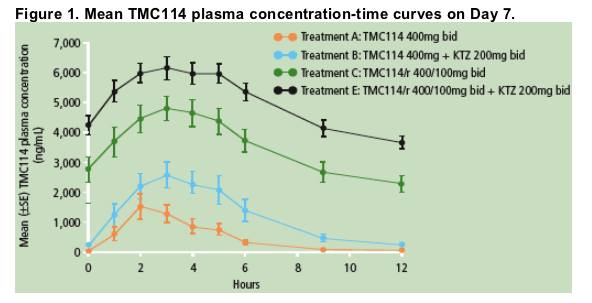
PK parameters of TMC114 for Treatments A, B, C and E are summarized in Table 1.
In the presence of KTZ (Treatment B), mean Cmin, Cmax and AUC12h values of TMC114 were significantly higher compared with TMC114 alone (Treatment A). Based on the LSM ratios, TMC114 Cmin, Cmax and AUC12h increased by 179%, 78% and 155%, respectively, with TMC114 and KTZ co-administration.
With combined TMC114/r and KTZ (Treatment E), mean C0h, Cmin, Cmax and AUC12h values of TMC114 were significantly higher compared with TMC114/r (Treatment C). Based on the LSM ratios, C0h, Cmin, Cmax and AUC12h
increased by 72%, 73%, 21% and 42%, respectively, with KTZ/TMC114/r.
Median tmax of TMC114 was 2-3 hours post-dose for all treatments.
The mean value of the TMC114 free fraction in plasma was lower with TMC114 alone (3.6% [range 2.9-4.5%]) than with TMC114/r (8.1% [range 3.3-13.3%]).
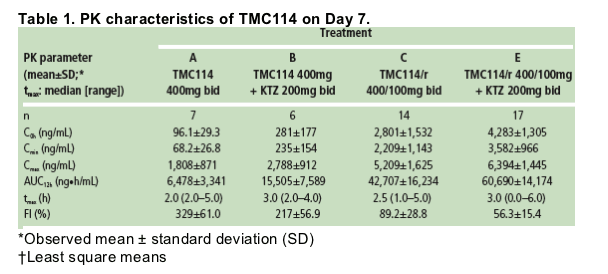
PK results for KTZ
- Steady-state conditions were achieved prior to PK blood sampling on Day 7.
- Mean plasma concentration-time curve of KTZ with TMC114 and KTZ (Treatment B) was comparable to that of KTZ alone (Treatment D). With TMC114/r and KTZ (Treatment E), the KTZ curve had a similar shape to the curves for TMC114 + KTZ and KTZ alone, but was positioned considerably higher (Figure 2).
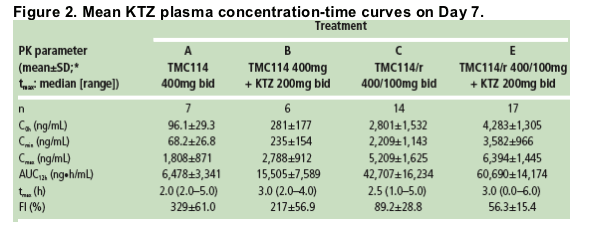
PK parameters of KTZ for Treatments B, D and E are summarized in Table 2.
Mean C0h, Cmax and AUC12h values of KTZ observed after treatment with TMC114/r and KTZ (Treatment E) were comparable to those observed after KTZ treatment alone (Treatment B).
In the presence of TMC114/r, mean C0h, Cmin, Cmax and AUC12h values of KTZ were significantly higher compared with KTZ given alone.
Based on the LSM ratios, C0h, Cmin, Cmax and AUC12h values of KTZ increased by 783%, 868%, 111% and 212%, respectively, when KTZ was co-administered with TMC114/r.
Median tmax of KTZ was 3 hours post-dose for all treatments.
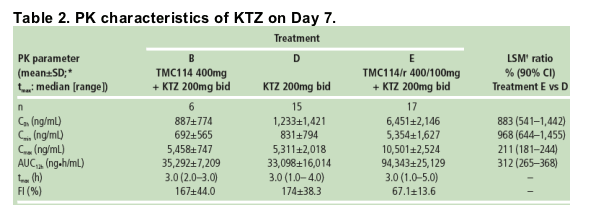
PK results for RTV
Comparable mean plasma concentration-time curves were observed for RTV, when it was co-administered with TMC114 alone or with TMC114 and KTZ (Figure 3).
At steady-state, mean C0h, Cmax and AUC12h values of RTV were 342ng/mL, 1,232ng/mL and 7,556ng-h/mL, respectively, when co-administered with TMC114, and 460ng/mL, 1,368ng/mL and 8,515ng-h/mL, respectively, when co-administered with TMC114 and KTZ. Systemic exposure to RTV was comparable between both treatments.
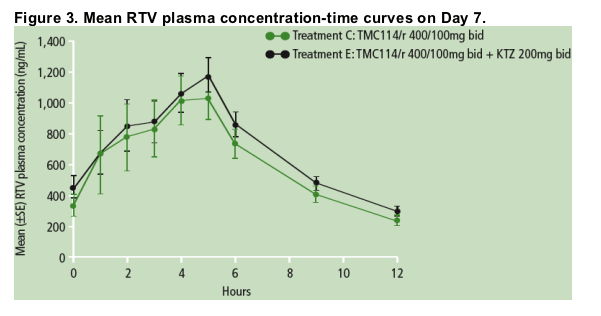
Median tmax of RTV was 4 hours post-dose for both treatments.
Safety and tolerability
No serious AEs were reported in this trial.
Of the 26 volunteers enrolled, 85% reported at least one AE during the trial.
The majority of AEs were grade 1 or 2 in severity. One grade 4 AE (maculopapular rash with an oral mucosal disorder) and two grade 3 AEs (increased lipase and increased pancreatic enzymes) were reported.
As requested per protocol, four volunteers (15%) discontinued due to an AE, specifically one case each of the following AEs:
- grade 4 cutaneous AE (maculopapular rash with an oral mucosal disorder reported 2 days after the last intake of TMC114 in Panel 1)
- grade 3 increased pancreatic enzymes (reported during screening)
- grade 2 localized urticaria and grade 3 increased lipase (both reported after 7 days of treatment with TMC114/r and KTZ in Panel 2).
Except for grade 3 increased pancreatic enzymes, all AEs that led to discontinuation were considered possibly related to study medication. All four cases resolved without sequelae.
The most commonly reported AEs were gastrointestinal disorders (2/8 [25%] in Panel 1; 8/18 [44%] in Panel 2) and headache (2/8 [25%] in Panel 1; 7/18 [39%] in Panel 2).
Hyponatraemia (44%) was the most commonly reported treatment-emergent laboratory abnormality. It was reported more frequently when KTZ was administered (alone or with TMC114). All cases of hyponatraemia were observed at only one timepoint and were not considered clinically relevant. They were not reported as AEs and considered to be possibly due to sampling problems.
|
| |
|
 |
 |
|
|